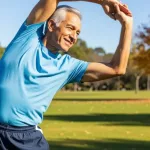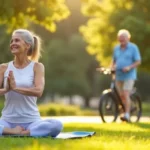
How mobility exercises are important for seniors?
Gaining mobility through targeted exercises can transform seniors' lives by enhancing independence and reducing injury risk, but how exactly does it work?


Regular physical activity is essential for seniors who want to stay healthy and independent. It can improve strength, balance, flexibility, and mental clarity.

But what types of exercises are most effective for seniors, and how can they safely build a routine that supports long-term wellbeing?
Although aging naturally brings physical challenges, regular exercise significantly enhances seniors’ health and mobility.
Consistent, low-impact activities improve muscle strength, joint flexibility, and balance, reducing fall risk. Tailored routines, performed safely under guidance, support cardiovascular health and endurance.
Prioritizing gradual progression and proper technique ensures effective benefits while minimizing injury, promoting sustained independence and quality of life for older adults.
Beyond physical benefits, regular exercise plays a significant role in supporting mental health and cognitive function among seniors.
Engaging in safe, low-impact activities helps reduce symptoms of anxiety and depression while promoting better memory and attention.
Consistent workouts encourage the release of mood-enhancing chemicals and protect brain health, making physical activity a secure and effective strategy for maintaining mental well-being in later life.
Regular physical activity significantly lowers the risk of developing chronic diseases common among seniors, such as heart disease, diabetes, and arthritis.
Safe, moderate exercise strengthens the cardiovascular system, improves blood sugar regulation, and maintains joint flexibility.
Seniors should consult healthcare providers to tailor workouts appropriately, ensuring effective disease prevention while minimizing injury risk.
Consistency and caution are essential for long-term health benefits.
When seniors participate in group exercise or fitness classes, they often experience increased social interaction, which can enhance emotional well-being.
This engagement helps reduce feelings of loneliness and isolation, promoting a positive mood.
Structured, supervised activities provide a safe environment for building connections, supporting mental health while encouraging consistent physical activity beneficial to overall quality of life.
Engaging in group exercise offers emotional benefits, but establishing a safe and effective workout routine requires careful planning tailored to seniors’ unique needs.
It is essential to start slowly, focus on proper form, and include warm-ups and cool-downs. Consulting healthcare professionals ensures exercises suit individual health conditions.
Prioritizing balance and flexibility helps prevent injuries and promotes long-term wellbeing.
Regular exercise is essential for seniors to maintain physical health, mobility, and mental well-being. By improving muscle strength, flexibility, and balance, it reduces the risk of falls and chronic diseases. Additionally, physical activity supports cognitive function and emotional health while fostering social connections. A safe and effective workout routine enables seniors to stay independent and vibrant, enhancing their overall quality of life and promoting long-term wellness.

Gaining mobility through targeted exercises can transform seniors' lives by enhancing independence and reducing injury risk, but how exactly does it work?

Find out the three fundamental strategies for active aging that fuel vitality and longevity—discover how they transform your life today.

Stay active and independent with these 4 best mobility exercises for seniors designed to boost flexibility and strength safely and effectively.

Unlock the secrets to gentle yet effective exercises tailored for seniors—discover which low-impact workouts boost health without strain. Your wellness journey starts here.